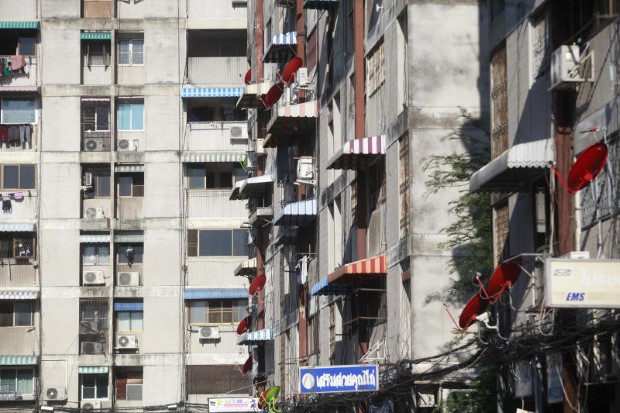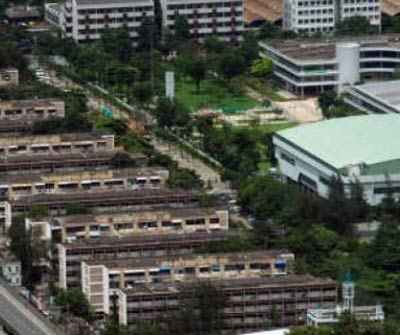I write this article to recap my work as an urban planner (formally Plan and Policy Analyst) at Office of the National Economic and Social Development Council of Thailand (NESDC). Urban planning has been assigned to the agency’s core responsibilities again in 2019 after being consolidated into special economic zone development work for roughly 20 years. Most of our urban team of 15 people are totally new to the field. I am the only officer with a degree in urban planning while two other team members have one in urban environment management. From the senior management’s point of view, NESDC has lost a lot of know-hows in urban planning during the 20-year hiatus.
Thus, from the “very humble beginnings” (literally) of Urban Development Strategy Division (UDSD) of NESDC, I want to set out the right track for my team. We may not able to deny some compulsory top-down approaches as they are the agency’s core value, but today where our urban development and social science toolkits are much more diverse, we must go above and beyond a comprehensive-rational approach to a more nuanced one.
Introduction
Since its rise at the turn of the 20th century, modern urban planning has evolved from top-down, non-partisan, and planner-as-a-technocrat point of view to bottom-up, advocative, and planner-as-a-moderator after Jane Jacob’s movement. Looking into Thai urban planning, the practice has moved back into the government’s interest in recent years because of the higher degree of urbanization. The Master Plan on Smart Livable Cities under the National Strategy has been enacted in 2019. In accordance with the National Strategy, Office of the National Economic and Social Development Council of Thailand (NESDC), the national-level planning agency, reestablished Division of Urban Development Strategy Division (UDSD) within the same year. However, considering the start of Thai urban planning practices in 1950s with heavy focus on physical aspects of cities and NESDC as a top-down think-tank agency, setting the values and roles for UDSD is a very challenging task. The main question is how UDSC will adapt to other paradigms of urban planning, while also serving as a national-level planning agency.
Content
- Planning Paradigm Recap
- Planning in Thai Contexts
- NESDC and Urban Planning
- How NESDC Works with Other Urban Development Agencies
- NESDC and New Planning Approaches
- Summary: Bottom-up in a Top-down World
Planning Paradigm Recap
Modern Urban Planning and Its Paradigm Shift in 1960s
The world of modern urban planning has started around 1890s in order to find solutions to unmanaged, polluted, overcrowded industrialized cities in Europe and the US. The eminent thoughts of the time such as City Beautiful Movement (Daniel Burnham, 1890 – 1900), Garden City (Ebenezer Howard, 1903), and Setback Principle (Hugh Ferris, 1916), offered city management ideas which heavily focused on good image and better environment of a city. Even two most prominent architects of the century exhibit the ideas of an ideal city in this period.
The first one is Le Corbusier. He proclaims the new way of human living in the industrial world in his ideal city idea ‘Radiant City’ (1933). A house is a machine for living in while a city is a machine for growth. Thus, humans shall live in pre-fabricated high-rise housings with centralized services such as canteen, daycare, and laundry to fully serve the industry in the city. Each apartment complex has identically looking units and shared spaces. There shall be highways connected between work and residential zones.
The other idea was Frank Lloyd Wright’s Broad Acre City in 1932. His concept offered ideal urban and suburban development. Inhabitants shall have their own plots of a specific size with community-based infrastructure and services. Automobile is the major mode of transport for everyone.
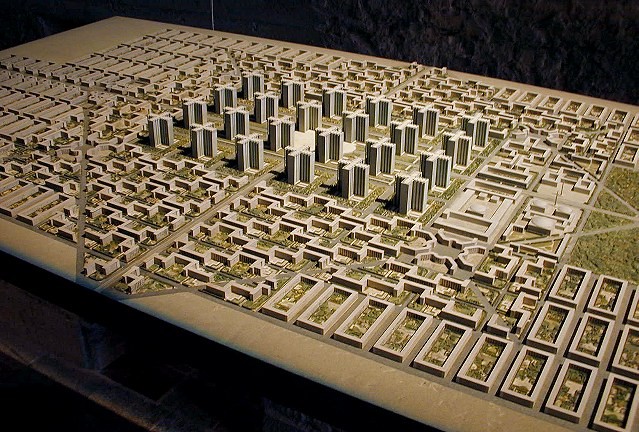
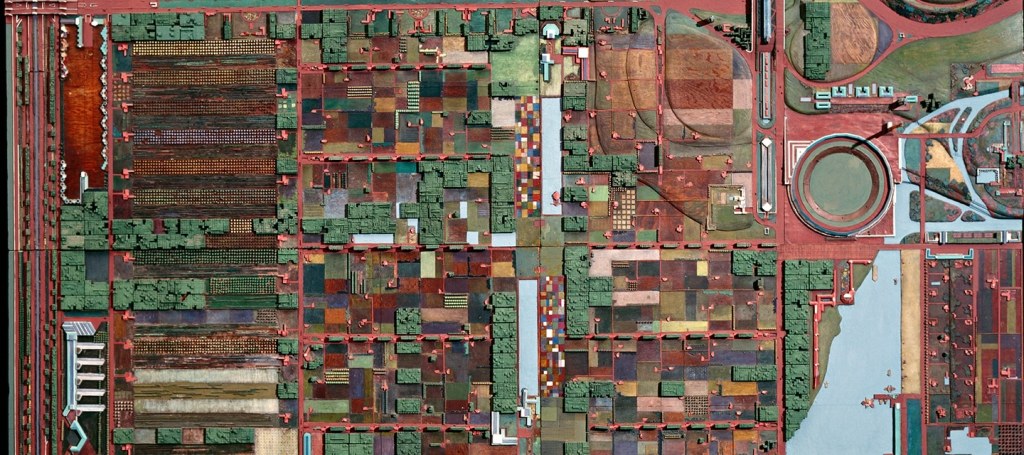
The model of Frank Lloyd Wright’s Broadacre City idea in 1935, photo from Frank Lloyd Wright Foundation’s Reading Broadacre (2018)
We can see that all ideas and thoughts in this era heavily focused on physical aspects of a city. Human and social interactions were almost never mentioned. City Beautiful Movement believed that beautification will promote a harmonious social order. Physical elements shape human’s behaviors, not the other way around.
This trend continued until the 1960s. Modern urban planning faced intense criticisms due to the neglect of human and social aspects, which led to high crime rates. Jane Jacobs’ ‘The Death and Life of Great American Cities’ (1961) became one of the most influential books that forever changed the paradigm of the urban planning world. The book attacked the principles and objectives of modernist ‘orthodox’ planning (specifically Garden City, City Beautiful Movement, and Radiant City) as it overlooked and oversimplified the complexity of human lives in diverse communities. Instead of promoting social order and efficiency as intended, they were detrimental to cities. Massive housing projects without consideration of human aspects led to planned slums. A successful neighborhood should be determined from social interactions among inhabitants. Therefore, instead of large-scale urban renewal programs such as highways and neighborhood demolition, she suggested dense mixed-use development, smaller blocks, and walkable streets which promote vibrancy and are the key to unslumming the city (Matthias Wendt, 2009, Susan Bertolino, 2012, and Carolina Pacchi, 2018).

Summary of paradigms in urban planning, material I used to teach my team before starting Policy Lab work in 2019, summarized from Cantrell Crowley’s The Evolution of Urban Planning
The Modernist Legacy
The demolition of Pruitt-Igoe complex, one of the largest housing projects in the US, is often cited as an example to demonstrate the downside of modern planning. The complex of 33 eleven-story apartment buildings was designed by Minoru Yamasaki and built in St. Louis, Missouri in 1955 to solve overcrowding of the city. It was highly praised by the media as the solution. Not long after the complex opening in 1956, it had become clear that the living conditions were appalling, due to the lack of building maintenance and upkeep. For a decade, the complex had been infested with poverty, crime, and racial segregation problems. All 33 buildings were demolished by explosion in the 1970s because the conditions were deemed too severe to improve. The demolition has become the sign of the end of the modern era.

Pruitt-Igoe Complex around 1963 – 1972, Photo from United States Geological Survey and Wikipedia 
2nd Demolition of Pruitt-Igoe apartment complex on April 1, 1972, Photo from U.S. Department of Housing and Urban Development and Wikipedia.
Planning Changes, Planners Change Too
During the modern planning era, planners were expected to be neutral technicians who provided suggestions from data without partisan interests, also known as the comprehensive-rational approach. However, after World War II, new planning theories emerged in accordance with the development of social sciences and skepticism about power and expertise (Harvery M. Jacobs, and URP 512 website). Planning paradigms were not only restricted to comprehensive-rational approach. New approaches, such as Incremental planning which states that planning should be done in short-term and narrow focus or Advocate-Progressive planning that encourages planners to be political and share values with the communities they are working with, were brought on to the planners’ working table.
| Comprehensive planning | Incremental planning | Advocate – Progressive Planning | |
| Started from | Modern planning | Post WWII | 1960s with social ferment |
| Reflective of | Notion of utopianism | New ideas in political sciences | Broad skepticism about power and expertise |
| The plan | Comprehensive, Long-term, General | Narrow, Short-term, Specific | Comprehensive, Short-mid term, Specific & general |
| The planner | Neutral, Technician | Neutral, Technichian | Political, Participatory- shared |
Planning in Thai Contexts
Modernism in Thailand
According to Evolution of Urban Planning of Thailand by Panpun Ronghanam (2015), modern urban planning ideas arrived to Thailand in the reign of King Rama V, after his official trip to Europe in 1907. City Beautiful was used for modernization of the Kingdom. Rachadamnoen Road, was built to connect the Royal Palace and Dusit Palace in the heart Bangkok; and intentionally designed to give a sense of grandeur via wide road space, sidewalks, and green stripes. Government buildings and palaces were built along the road while smaller shophouses were banned. Even its name was taken from Queen’s Walk in London (Racha – monarch, damnoen – walk), reinforcing the holistic idea of the City Beautiful Movement. Waterworks, electricity, railroads, and telecommunication infrastructure were built and expanded to other cities.
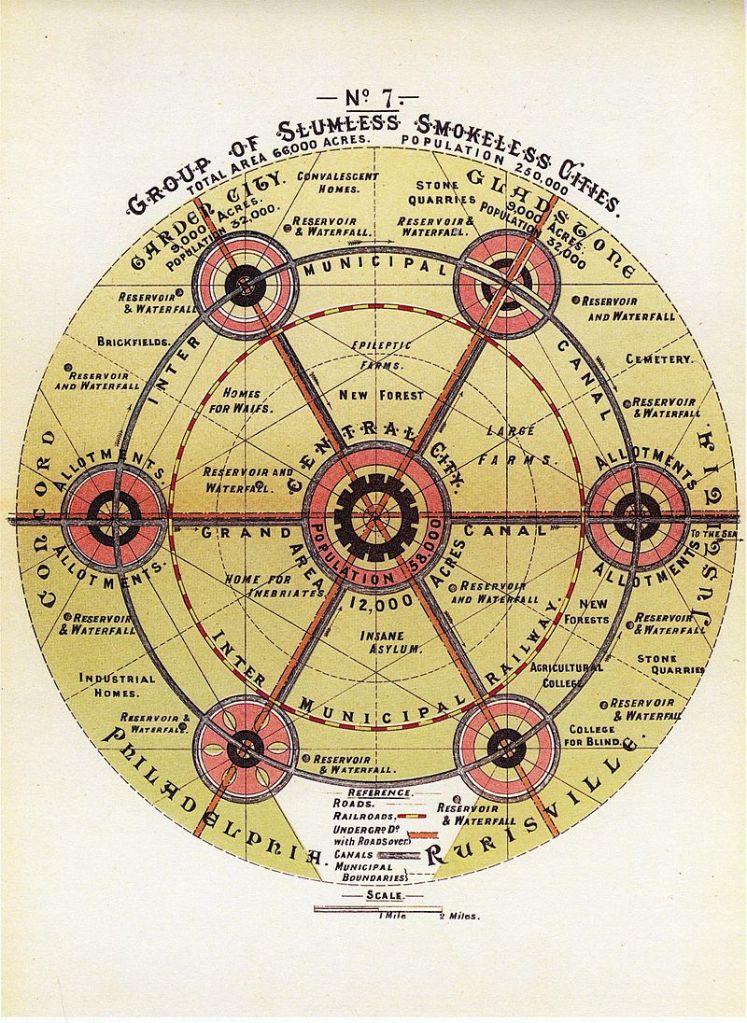
Ebenezer Howard’s Garden City Idea, Diagram No.7 on 1898 (Wikipedia, 2020) 
Yala City’s bird eye view (Thailandtravel, 2011)
After the Siamese revolution for democracy in B.E 2475 (1932), planning was no longer dictated by the king but the government. Town and Country Planning Act of B.E. 2594 (1952) was the first planning law of the country. It focused mostly on the physical aspects of cities. The ideas and frameworks were influenced by Garden City idea and directly adapted from the UK’s Town and Country Act 1944.
The other aspects of urban planning were added in Town Planning Act of B.E. 2518 (1975), which used the rational comprehensive approach. However, it still lacked of public participation and positive reinforcement measures. The act has been amended 4 times up until B.E. 2558 (2015).
The current Town Planning Act of B.E. 2562 (2019) has a much broader scope of focus and stronger sense of ‘urban and regional planning’.
Thai Modernist Legacy
To support the fast-growing economy of Thailand while solving the supply shortage of housings due to immigration of workforce during 1960s – 1980s, the public housing project ‘Flat Din Daeng’ was built in Din Daeng district, Bangkok’s urban center in 1963 for low-income population. Then National Housing Authority was founded in 1973 to be formally responsible for the extension of the initiative to other sites in Bangkok and its vicinity. The agency still exists today working for the whole country. NHA housings contained mostly small modular units in order to fit as many rooms as possible into the buildings. The buildings were usually low-rise with identical looks, sharing a park and other communal spaces. These NHA housings share a lot of ideas and characteristics with Pruitt-Igoe.
As Pruitt-Igoe narrates the modernist legacy for the western world, NHA housings also share some stories. There were long disputes between the tenants and NHA about the demolition and rebuilding. Because Flat Din Daeng had been built for more than 50 years, the conditions were considered ‘unsafe’ in terms of structural engineering. Thus, NHA had planned to demolish and rebuild some buildings for safety and density increase since 1987. However, the controversies continued until 2006 because the tenants could not find any alternative with comparably low rent. The demolition and construction is still ongoing as of today (Realist’s article).
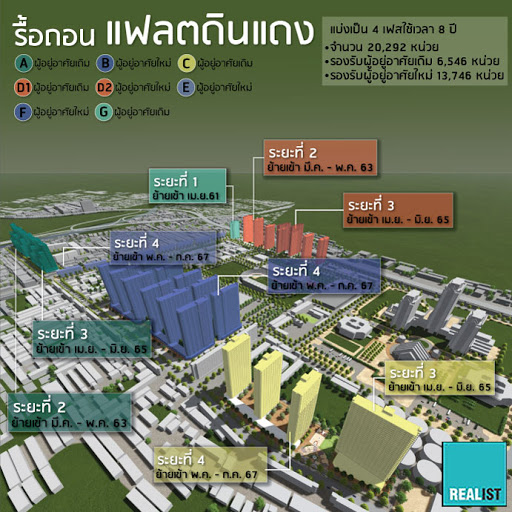
Flat Din Daeng’s new plan on the same plot of land, photo from Realist’s article 
Flat Din Daeng’s collapse during the demolition on April 2, 2019, photo from Thai Post’s news article on April 3, 2019
In addition to the reconstruction controversies, the conditions of the complex are degenerative. As no annual fees are collected for maintaining the buildings and their surroundings, the buildings and shared spaces have significantly deteriorated. The shared parks have become well-known drug trafficking spots at night.
By and large, the modernist utopia is very challenging to achieve. It requires a high budget and perfect execution to maintain the environment, and subsequently shape order and harmony of the society as intended. Nowadays when we have a more diverse set of tools for planning, planners should not limit ourselves to the comprehensive-rational approach.
NESDC and Urban Planning
Due to rapid urbanization, Thai government has renewed its interest in urban planning in recent years. The National Strategy enacted in 2018 clearly states urban development as its agenda. In accordance with the enactment, NESDC reestablished Division of Urban Development Strategy Division (UDSD) in 2019 after being consolidated into special economic zone development work for roughly 20 years. The division is responsible for urban-related issues such as zoning laws, land adjustment, historical town preservation, green and resilient cities, and smart cities. Urban-related works discussed in this article are performed by UDSD.

Higher rate of urbanization brings Thai government’s interest in the issue 
Urbanization is considered the most certain with the highest degree of impact on global economy (Frost & Sullivan, 2014)
NESDC’s Conventional Roles: Plan Making
The major and undeniable roles of NESDC are high-level comprehensive plan making, coordinating with other government agencies for the implementations of such plans, as well as monitoring and evaluation of such implementations. There are three major plans namely: National Strategy, Master Plan under the National Strategy, and National Economic and Social Development Plan. They are all strategic plans with which most other operational plans have to comply.
In terms of urban development, all three plans discuss the high-level concepts of how targeted cities should be developed. Common keywords in the plans are such as inequality reduction, adequate housings, inclusive public transportation, waste management system, urban databases (see diagram below). Ministries, departments, and other government agencies are obliged to create action plans and implement them in accordance with these three plans.

Levels of Thai policy plans, red asterisks indicate NESDC responsibilities 
Targeted areas written in Master Plan on Smart Livable Cities and 12th Economic and Social Development Plan, from NESDC’s presentation at ASA Real Estate Forum 2019 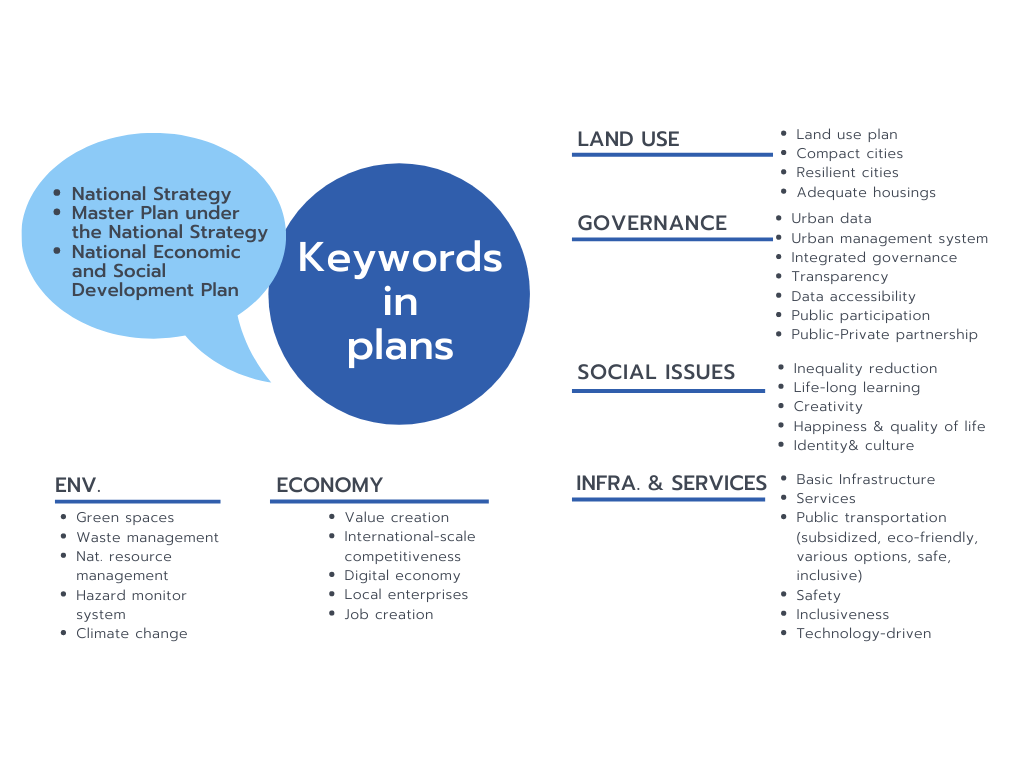
Keywords mentioned in National Strategy, Master Plan, and National Economic and Social Development Plan
How NESDC Works with Other Urban Development Agencies
Thai government system is divided into 3 levels: central, regional, and local (Government Administration Act B.E. 2534 (1991)). Each of them has a different scope of works and characteristics. NESDC works with government agencies of all levels as follows.

Thai government administration structure
Central Government
Central government consists of Prime Minister’s Office, ministries, sub-ministries, departments, and government enterprises and government public organizations under the ministries. On the ministry level, NESDC coordinate with them to make sure that the ministries understand and are able to implement the plans. Ministries that work closely with NESDC in urban planning are Ministry of Interior (zoning law, land readjustment, and local administration), Ministry of Digital Economy (Smart City Initiative), and Ministry of Natural Resources and Environment (old town preservation).
On the department level, NESDC may work directly with the agencies through the committee structure. For instance, NESDC is involved in all processes of zoning laws and regulations through committee bodies such as Zoning Committee and its subcommittees on preparation, monitoring & evaluation. The other committee structures of the departments working with NESDC are listed below:
- Department of Public Works and Town & Country Planning: Zoning Committee, Zoning Constitution Preparation Working Group, Land Adjustment Fund Committee
- Digital Economy Promotion Agency and Smart City Office: Smart City Committee, Smart City Proposal Screening Working Group
- Office of Natural Resources and Environmental Policy and Planning: Old Town Preservation and Development Committee, Sustainable Environment City Guideline Working Group
Regional Government
Regional government are regional offices of the departments which can be divided into 2 levels: provincial offices (สำนักงานจังหวัด) and district offices (สำนักงานอำเภอ).
Provincial officers are assigned from the departments in central government and work under the governor and the assigned provincial director. For instance, under the provision of Town Planning Act B.E. 2562, Provincial Office of Department of Public Works and Town & Country Planning (สำนักงานโยธาธิการและผังเมืองจังหวัด) is granted duties to prepare zoning laws and regulations within the province and propose them to the Department of Public Works and Town & Country Planning before submission to the Zoning Committee.
Meanwhile, district offices are similar to provincial offices with less authorities and duties. Duties and resources, such as officers and budget, are assigned from the governor.
NESDC usually works with regional government through the committee structures in the central government. On zoning laws and regulation process, NESDC is a chair of Zoning Committee and its subcommittees, considering zoning regulation proposals of Provincial Offices of Department of Public Works and Town & Country Planning. The other way to work with regional government is formal and informal communications with the governor when NESDC has to work within the province.
Local Government
Local government is a decentralized form of government administration and is granted partial autonomy. It consists of Provincial Administrative Office (PAO), Tessaban or municipality, Subdistrict Administrative Office (SAO), as well as the Special Governed Cities namely Bangkok and Pattaya City. In terms of urban development, Tessaban is the major player in the field. It can be divided into 3 types by minimum population:
- Tessaban Nakhon (population 50,000 or higher)
- Tessaban Mueang (population 10,000 or higher) and
- Tessaban Tambon (no minimum population)
Under the provision of Tessaban Act B.E. 2496 (1953) and its amendments, all types of Tessaban are granted urban development duties. Tessaban Nakhon has the most diverse set of duties due to its bigger population size. The duties are such as electricity & water services, waste management, public safety, healthcare, education, local roads, and cultural issues.
NESDC works with local government, strictly Tessaban, in some capacity-building projects. The approach of working with Tessaban is not conventional top-down as will be discussed in details in the next section.
NESDC and New Planning Approaches
Even though we cannot deny the top-down nature of NESDC, Thai urban development agencies exist in all levels of government administration. A lot of urban agendas in the National Strategy, Master Plan under the National Strategy, and National Economic and Social Development Plan have to be executed at the regional and local levels. These policies cannot be implemented by regional and local government effectively if NESDC cannot build adequate understanding with the locals. Using waterfall, top-down communications are like playing the telephone game. Ideas and messages can be lost along the line of communications to local government. Vice versa, NESDC and the central government cannot recognize challenges and struggles of the policy implementation at the local level and cannot adapt their policies effectively. Thus, it is not only value-added but compulsory for NESDC to work with all different levels of government as effectively as possible.
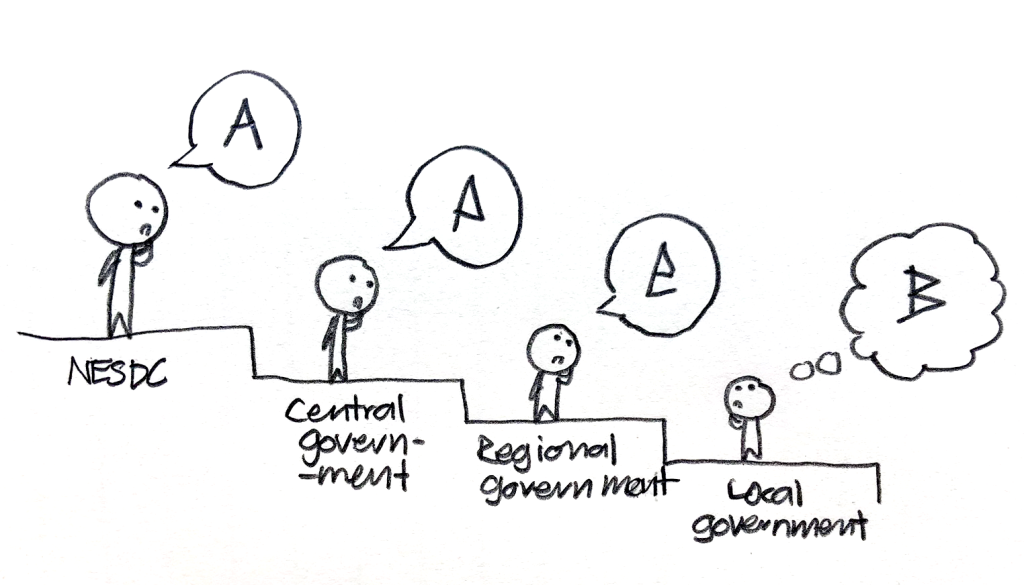
The telephone game of policy implementation is undesirable. 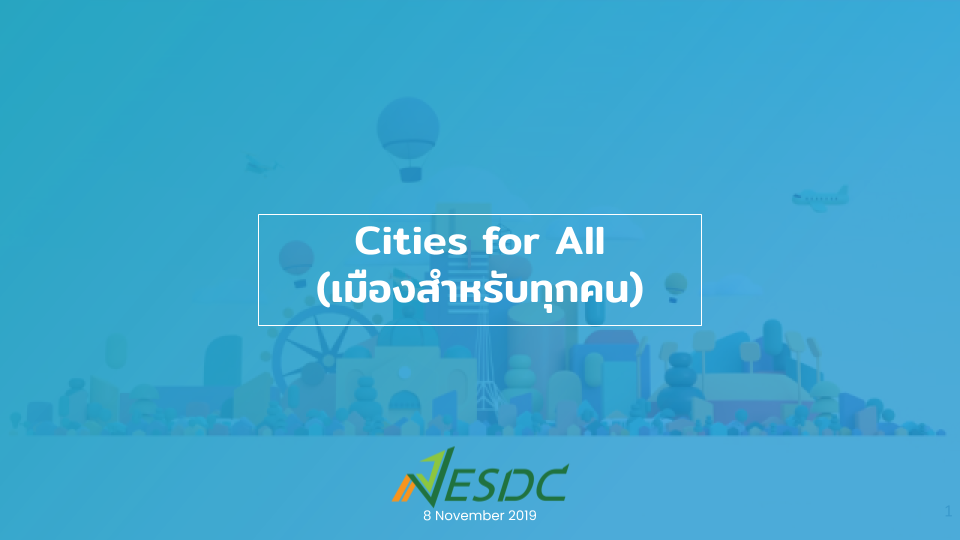
‘City for All’, NESDC talk on future of Thai cities at ASA Real Estate Forum 2019 by Mr. Suriyon Thunkijjanukij 
‘City for All’, NESDC talk on future of Thai cities at ASA Real Estate Forum 2019 by Mr. Suriyon Thunkijjanukij
NESDC has utilized bottom-up approach planning at Tessaban level in UDSD‘s projects namely Reimagine Ranong and Urban Development for Sustainable Living.
Reimagine Ranong: the NESDC Policy Lab
Reimagine Ranong is an experimental urban development project during December 2018 – August 2019, under NESDC Policy Lab Initiative. The main goal is to explore new approaches of policy-making process to be more connected to the real needs of citizens, using Design Thinking (DT) as a tool. Policy Lab has 3 working teams on different topics – (1) Thai future of work, (2) government services for SMEs, and (3) urban development in Ranong or ‘Reimagine Ranong’.
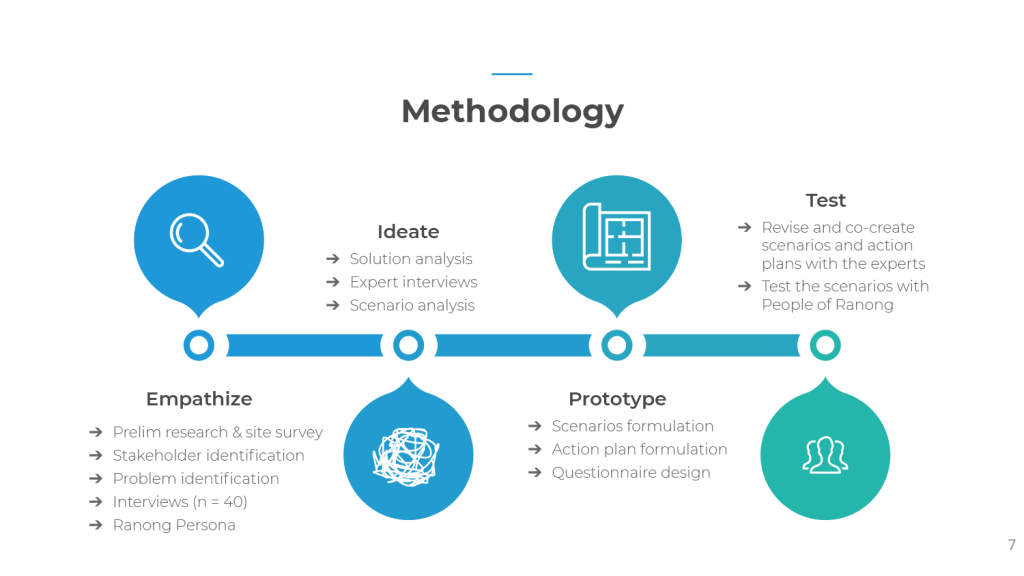
Reimagine Ranong’s methodology, image from NESDC KM Policy Lab presentation (December, 2019)
UDSD worked with Ranong citizens, Ranong local government agencies (Provincial Administrative Office, and Tessabans), local experts, and other field experts in all Design Thinking steps: Empathize, Define, Ideate, Prototype, and Test. During the Empathize phase, we found that Ranong is facing strains in transition of economy from fishery to tourism, due to the stricter Illegal, Unreported and Unregulated Fishing (IUU) regulations. The other challenge is the tension between natural conservation and land development. We ideate that Ranong must not sacrifice its nature for unsustainable tourism and shall utilize its world-class hot springs and RAMSAR mangrove sites. For the Prototype, we created and visualized scenarios for effective communication of finding the shared vision among the city’s stakeholders. The Test result shows that the stakeholders of Ranong believe in their pristine nature and prefer to utilize these strengths to become Ranong Wellness City.
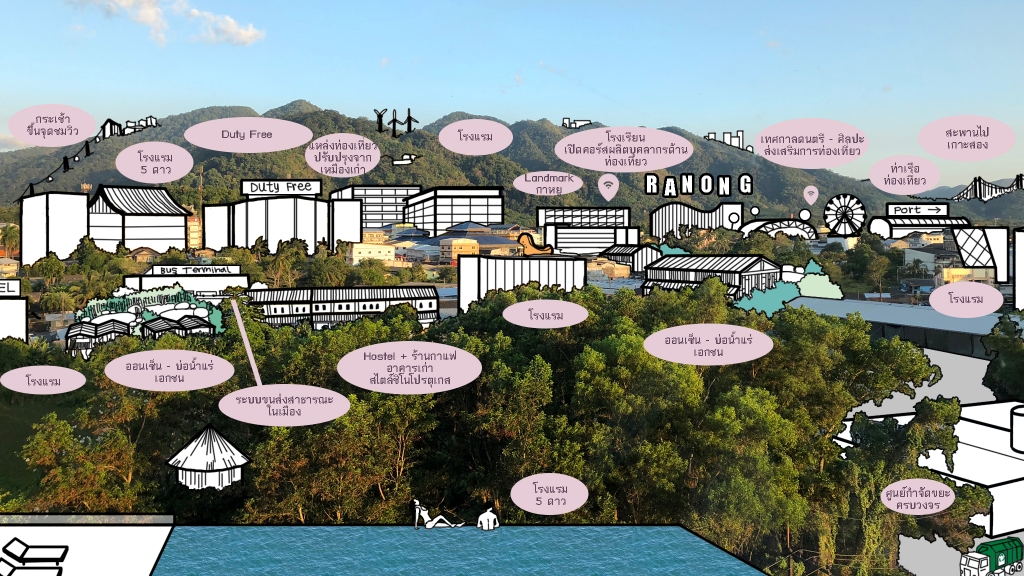
Ranong ‘Mass-Tourism City’ Scenario, image from NESDC KM Policy Lab presentation (December, 2019) 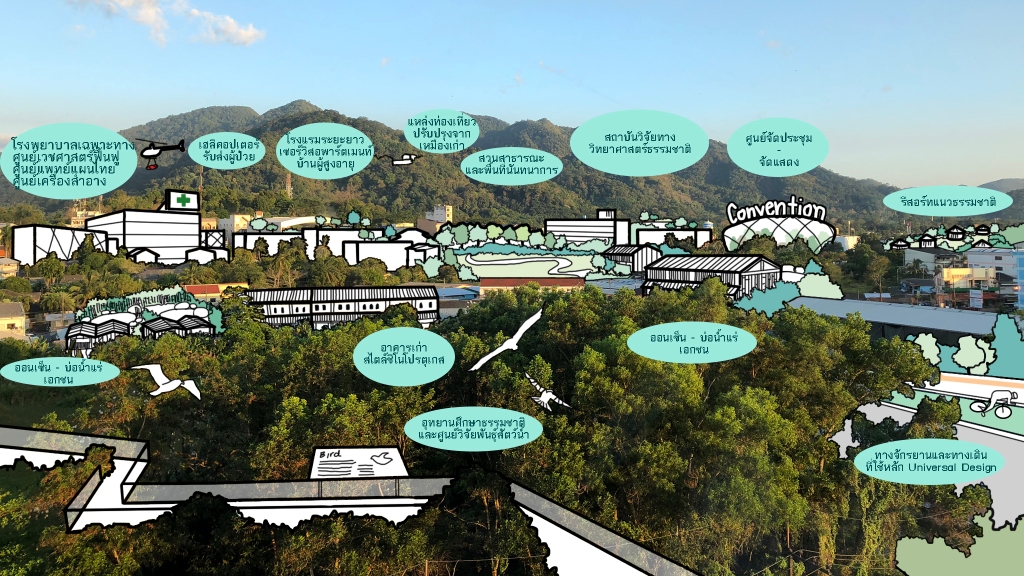
Ranong ‘Wellness City’ Scenario, image from NESDC KM Policy Lab presentation (December, 2019) 
The scenarios’ survey result, image from NESDC KM Policy Lab presentation (December, 2019)
Reimagine Ranong is the first project that UDSD worked directly with the locals. It helps the team to better understand the city, the local agencies, and how NESDC should work with them. Learning from this experience, we went on to work at Tessaban level on the Urban Development for Sustainable Living project.
Urban Development for Sustainable Living
Urban Development for Sustainable Living is another initiative of NESDC to support urban development at the local scale. The project started in 2015 with Japan International Cooperation Agency (JICA) cooperation called Sustainable Future City Initiative (SFCI). Eight model Tessabans were selected to work with the consultant teams on developing their own 5-year urban development plans and initiating pilot projects based on their contexts and needs:
- Tessaban Nakhon Chiang Rai: “Chiang Rai, City of Happiness for All” by promoting interactions among people of all age groups through active learnings
- Tessaban Nakhon Khon Kaen: “Create a Happy and Global Society” by going beyond car-oriented development
- Tessaban Nakhon Phitsanulok: “Central Center with Nice Landscape and Happy Citizens” by expanding of green space networks
- Tessaban Mueang Nan: “Nan – A Living Old Town Filled with Happiness” by promoting tradition, culture, and local wisdom through tourism
- Tessaban Mueang Phanat Nikhom: “Livable City” by improving elderly-friendly urban services
- Tessaban Mueang Krabi: “Art-Cultural City with Tourism” by promoting art-culture tourism
- Tessaban Mueang Ranong: “Becoming a leading health tourism city, creative agriculture, livable cities in which people have good health and open trade doors through the Andaman coast”
- Tessaban Mueang Chumphon: “Chumphon, the city of agriculture and quality tourism, linking the development of two sea sides”

Maps of the SFCI model cities. Blue indicates the 1st phase city (2015 – 2018). Green indicates the 2nd phase city (2019 – 2020). Image from NESDC KM Policy Lab presentation (December, 2019) 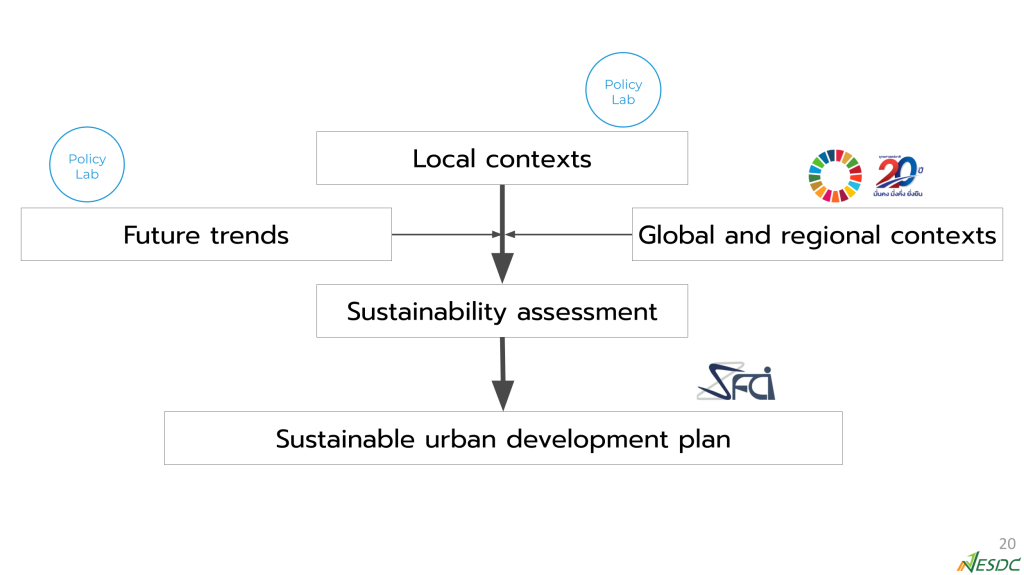
How Policy Lab initiative and SFCI compliment each other in the process of urban development plan preparation. Image from NESDC KM Policy Lab presentation (December, 2019)
Currently, UDSD continues the initiative under the name Urban Development for Sustainable Living. Two new pilot cities are selected, namely Tessaban Mueang Sukhothai Thani and Tessaban Mueang Lampang. The goal is to build capabilities of local agencies to be able to project their vision and prepare their own comprehensive plans, learning from the previous eight model cities. As the project evolves, UDSD intends to stick to the idea of working closely with local government agencies
Summary: Bottom-Up in A Top-Down World
To effectively implement the National Strategy, Master Plan under the National Strategy, and National Economic and Social Development Plan, NESDC must act as a bridge between local agencies and the urban development units of the central government. At different levels of government administration, the challenge of UDSD then is to find the right balance between one extreme of top-down, comprehensive-rational paradigm and the other of understanding Thai cities from the local perspectives in order to suggest the most suitable urban development plans and policies.
Appendix
NESDC history and roles
NESDC was founded in 1950 as National Economic Council (NEC). Its major responsibility was to provide opinions and recommendations on national economic issues to the government. It had been restructured and renamed as the Office of the National Economic Development Board (NEDB) in 1959 to be responsible for Economic Development Plan which was first published in 1961. The name was changed again 1972 to be National Economic and Social Development Board (NESDB), to recognize social development as its core value.
The final restructure was in 2018, due to the enactment of National Strategy B.E. 2560 – 2580 under the provision of National Strategy Preparation Act B.E. 2560 (2017). NESDC is assigned to be the secretary of National Strategy Committee, National Strategy Preparation Committee, and National Reform Committee. These missions tremendously affects the framework of the agency. Hence, NESDB has been restructured under the provision of National Economic and Social Development Council Act B.E. 2561 (2018) to become National Economic and Social Development Council (NESDC), changing its management structure from ‘board’ to ‘council’ which allows more advanced committee composition. The major goal is to support National Strategy and National Reform Plan frameworks.
Duties and roles of NESDC can be divided into 2 major bodies: National Economic and Social Development Council and Office of the National Economic and Social Development Council.
National Economic and Social Development Council consists of the chair and 15 assigned experts. It is responsible for (1) preparing National Economic and Social Development Plan (2) providing suggestions regarding socioeconomic issues and recommendations to the cabinet and (3) screening government agencies and government enterprises’ budget proposals.
Office of the National Economic and Social Development Council has 3 major functions as a strategic unit, an intelligence unit, and a knowledge organization. Its tasks include:
- Working as the secretary of the council
- Preparing socioeconomic studies, suggestions, and recommendations for the cabinet
- Coordinating with other agencies for preparing the National Economic and Social Development Plan
- Screening government agencies and enterprises’ project proposals
- Monitoring and evaluation
- Preparing investment and budget proposal frameworks of government enterprises
UDSD responsibilities as in the Act
Section 16. Urban Development Strategy Division shall have the duties as follows:
- Study and analyze international and domestic change contexts and knowledge development related to urban development, to recommend related policies, strategies, plans, projects, guidelines, and measurements
- Plan and conduct urban development policies and strategies related to National Economic and Social Development Plan, and the state policies
- Create and develop urban development-related database system
- Analyze and prioritize urban development policies, plans, and projects of the country, and propose to the cabinet
- Coordinate and support urban development strategies for tangible and integrated implementation, to create effective and efficient urban development
- Study and analyze land use to support effective and sustainable urban development
- Coordinate and cooperate with related public and private agencies to work on zoning, land adjustment for spatial development, watershed-based and other related spatial development; and provide comments and recommendations on zoning regulation to the cabinet
- Monitor and evaluate operation and implementation of urban development policies; analyze, conduct research, and create and develop database system; to support making of urban development policies, strategies, plans, and projects of the country
- Cooperate or support related work of related agencies or assigned work
NESDC Plan Related to Urban Development
National Economic and Social Development Plan
The National Economic and Social Development Plan, published every 5 years since 1961, is the most well-known publication by NESDC. The current version is the 12th one of B.E. 2560 – 2564 (2017 – 2021). The plan covers all economic and social development issues and strategies of the next 5 years which other function plans by other ministries have to comply.
Urban development is a part of Strategy 9 in the 12th plan: Regional, Urban, and Economic Zone Development. The framework is decentralization, regional urban centers, economic revitalization, competitiveness, and sustainable development. The framework is divided into 2 categories: general and targeted-city guidelines.
The general guidelines discuss about regional urban centers, city environment management, city public transportation, identity and cultural preservation, and good governance.
Meanwhile, targeted-city guidelines assign:
- Bangkok – world class business, education, and health center
- Bangkok’s vicinity – service and logistics centers
- Chiang Mai and Phitsanulok (urban centers of the Northern) – health , education, and digital businesses centers
- Khon Kaen and Nakhon Ratchasima (urban centers of the Northeastern) health and education business centers
- Phuket and Hatyai (urban centers of the Southern) to be sustainable and livable cities of the region
- Transit-Oriented Development (TOD) in potential cities
National Strategy and Master Plan on Smart Livable Cities
The other national plan related to urban planning NESDC is responsible for is National Strategy, the plan of the highest hierarchy which the other government plans have to comply. It was enacted under the provision of Section 65 of the Kingdom of Thailand B.E. 2560 (2017), the government shall prepare and enact National Strategy to be the country’s development guidelines. Followed by the provision of Section 10 of National Strategy Preparation Act B.E. 2560 (2017), after the enactment of National Strategy B.E. 2561 – 2580 (2018 – 2037), all 6 National Strategy Preparation Committees shall prepare master plans for achieving the goals written in the Strategy. NESDC is responsible for preparation, monitoring, and evaluation of National Strategy and its Master Plans.
The Master Plan on Smart Livable Cities is the 6th plan among all 23, serve the National Strategies on Competitiveness, Social Cohesion and Just Society, and Sustainable Development and Growth. Its main framework is to serve the country’s urbanization trend by encouraging mid-size cities in all regions.

